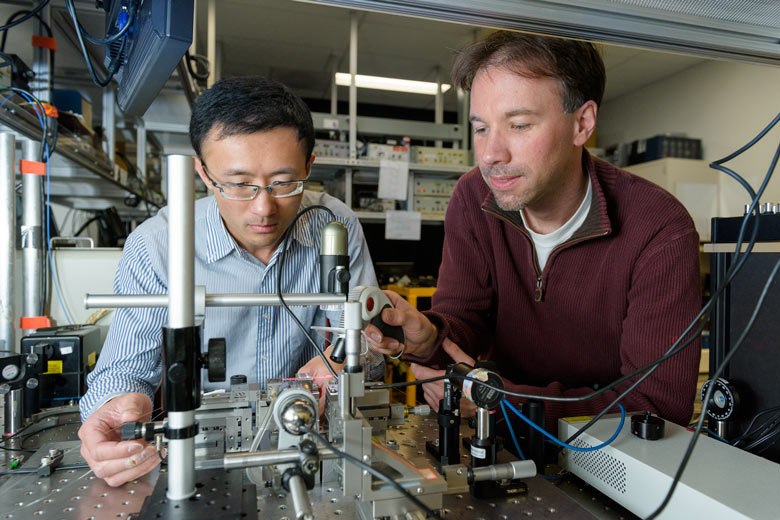破解了量子物理学难题 有助量子计算机研发
据美国斯坦福大学官方网站报道,近日该校物理学家余利奥和他的科研团队让相隔1.2英里的光子和自旋的电子发生了关联。这项研究解决了量子物理学领域老大难问题——如何远距离传输“纠缠”的粒子。
量子纠缠是两个或更多粒子在不同的空间即使相距几千里也互相关联的现象。以纠缠的电子为例,电子自旋的方向有两种,如果两个电子发生了纠缠,它们的自旋方向也会发生联系。爱因斯坦曾把这种现象称为“幽灵般的行为”。
电子被困在原子之中,所以纠缠的电子无法通过长距离直接发生“对话”,不过光子却可以。因此,科学家可以先让光子和电子发生所谓的“量子关联”,这样光子就可充当信使的作用,传达电子的自旋信息。
为实现这一目的,余利奥团队需要保证光子和电子在长距离传输中一直保持关联,这是个很关键的挑战,因为光子在光纤电缆中传输时有改变方向的倾向。光子可有两种方向——垂直或水平,不过如果光子的方向在途中发生改变,它与电子的关联就消失了。余利奥设计了一种时间戳来将光子的到达时间与电子自旋发生关联,这可以为每个光子提供参考信息来确认它与哪个电子相互关联。
为最终让两个从未谋面的电子在远距离发生纠缠,科研人员需要将分别与不同的电子发生关联的光子通过光纤发送出去,让它们在中间的分束器中汇合并互动,这就需要让光子发生双光子干涉。但是来源不同的光子会有不同的颜色或波长等,而波长不同的光子无法互相干涉。为克服这个困难,科研人员在光子传输前,让其通过量子降频变换器使波长达到一致,最终成功地让光子为相距1.2英里的电子捎上了信儿。
“这项工作可为未来在全球范围内实现数据高度安全传输的量子通信网络做铺垫。”余利奥补充道,与传统计算机相比,量子超级计算机的速度将实现指数级的飞跃,而他们的研究也让量子计算机离现实更近了一步。
总编辑圈点
电子的自旋特性让它成为了能装载复杂信息的货箱,但要把自旋电子器件应用于量子计算机,还需要一位运货的“车夫”。现在科学家让光子很好地担起了这个责任。接近两公里之外的关联,不但向人们展示了量子现象与传统经验之间的差异有多大,也为开启超快量子计算、超安全量子密码等下一代未来技术提供了钥匙。
Stanford physicists set quantum record by using photons to carry messages from electrons over a distance of 1.2 miles
By using photons to communicate between two electrons through more than a mile of fiber optic cable, physicists have taken an important step toward proving the practicality of quantum networks.
By Bethany Augliere
L.A. Cicero

Postdoctoral scholar Leo Yu, left, and senior research scientist Carsten Langrock epoxy optical fibers to a nonlinear optical waveguide that converts the wavelength of a single-photon signal to a common telecom wavelength, thereby enabling communication to a next node over long distances.
Researchers from Stanford have advanced a long-standing problem in quantum physics – how to send "entangled" particles over long distances.
Their work is described in the online edition of Nature Communications.
Scientists and engineers are interested in the practical application of this technology to make quantum networks that can send highly secure information over long distances – a capability that also makes the technology appealing to governments, banks and militaries.
Quantum entanglement is the observed phenomenon of two or more particles that are connected, even over thousands of miles. If it sounds strange, take comfort knowing that Albert Einstein described this behavior as "spooky action."
Consider, for instance, entangled electrons. Electrons spin in one of two characteristic directions, and if they are entangled, those two electrons' spins are linked. It's as if you spun a quarter in New York clockwise, an entangled second coin in Los Angeles would start to spin clockwise. And likewise, if you spun that quarter counter-clockwise, the second coin would shift its spin as well.
Electrons are trapped inside atoms, so entangled electrons can't talk directly at long distance. But photons – tiny particles of light – can move. Scientists can establish a necessary condition of entanglement, called quantum correlation, to correlate photons to electrons, so that the photons can act as the messengers of an electron's spin.
L.A. Cicero
This nonlinear optical wave guide converts the wavelength of a single-photon signal to a common telecom wavelength.
In his previous work, Stanford physicist Leo Yu has entangled photons with electrons through fiber optic cables over a distance of several feet. Now, he and a team of scientists, including Professor Emeritus Yoshihisa Yamamoto, have correlated photons with electron spin over a record distance of 1.2 miles.
"Electron spin is the basic unit of a quantum computer," Yu said. "This work can pave the way for future quantum networks that can send highly secure data around the world."
To do this, Yu and his team had to make sure that the correlation could be preserved over long distances – a key challenge given that photons have a tendency to change orientation while traveling in optical fibers.
Photons can have a vertical or horizontal orientation(known as polarization), which can be referenced as a 0 or a 1, as in digital computer programming. But if they change en route, the connection to the correlated electron is lost.
This information can be preserved in another way, Yu said. He created a time-stamp to correlate arrival time of the photon with the electron spin, which provided a sort of reference key for each photon to confirm its correlation to the source electron.
To eventually entangle two electrons that had never met over great distances, two photons, each correlated with a unique source electron, had to be sent through fiber optic cables to meet in the middle at a "beam splitter" and interact. Photons do not normally interact, just two flashlights beams passing through one another, so the researchers had to mediate this interaction called the "two-photon interference."
To ensure the two-photon interference, they had another issue to overcome. Photons from two different sources have different characteristics, like color and wavelength. If they have different wavelengths, they cannot interfere, Yu said. Before traveling along the fiber optic cable, the photons passed through a "quantum down-converter," which matched their wavelengths. The down-converter also shifted both photons to a wavelength that can travel farther within the fiber optic cables designed for telecommunications.
Quantum supercomputers promise to be exponentially faster and more powerful than traditional computers, Yu said, and can communicate with immunity to hacking or spying. With this work, the team has brought the quantum networks one step closer to reality.
The paper is published online in Nature Communications. In addition to Yu and Yamamoto, it was co-authored by Martin Fejer, Tomoyuki Horikiri, Carsten Langrock, Chandra Natarajan, Jason Pelc, Michael G. Tanner, Eisuke Abe, Sebastian Maier, Christian Schneider, Sven Höfling, Martin Kamp, and Robert H. Hadfield.
The work was supported by the Japan Society for the Promotion of Science, the National Science Foundation, the National Institute of Information and Communications Technology, the National Institute of Standards and Technology, Special Coordination Funds for Promoting Science and Technology, and the State of Bavaria. Funding also came from the Air Force Office of Scientific Research, SU2P Entrepreneurial Fellowship and Royal Society University Research Fellowship.

















